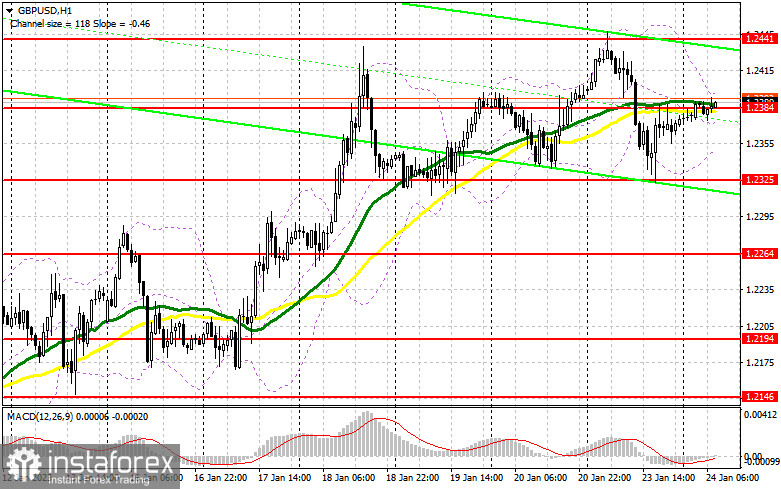A few entry signals were generated on Friday. Let's take a look at the M5 chart to get a picture of what happened. In the first half of the day, a false breakout through 1.2392 produced a buy signal. The pair went up by 30 pips but failed to reach the target at 1.2441. The quote retested the level of 1.2392 and then broke through it. However, I did not sell GBP/USD because there had been no upside retest. When the price fell in the North American session, a false breakout through 1.2321 made a buy signal, and the quote soared by 50 pips.

When to open long positions on GBP/USD:
Before we conduct technical analysis, let's look at the situation in the futures market. According to the Commitments of Traders report for January 17, the number of long and short positions increased. It is important to understand that the Fed's aggressive policy is no longer as effective as it used to be. A slowdown in economic growth and a decrease in retail sales are the first signals of a looming recession in the US. At the same time, the Bank of England keeps fighting against inflation. Although the reading fell slightly, it is still not enough for the regulator to change its monetary stance. Therefore, aggressive tightening is likely to go on. That could help the pound offset previous losses. According to the latest COT report, short non-commercial positions increased by 703 to 66,166. Long non-commercial positions surged by 5,4628 to 41,469. Consequently, the non-commercial net position came in at -24,697 versus -29,456 a week ago. These are insignificant changes. Therefore, they are unlikely to affect market sentiment. That is why it is important to monitor macroeconomic reports in the UK as they could help understand what the BoE could do next. The weekly closing price of GBP/USD increased to 1.2290 from 1.2182.

A series of business activity reports will be delivered in the UK today. If data comes in line with the forecast, the pair will highly likely face stronger pressure. That is why long positions should be considered after a false breakout through 1.2325, which is also the lower limit of the sideways channel. A buy signal will confirm the presence of the bulls in the market. The price will be able to return to 1.2384. This is also the level where the bearish moving averages pass. If the pair goes above the mark and UK macro data comes upbeat, the uptrend may extend. A breakout and a retest of the 1.2384 mark to the downside will drive the pair to the monthly high of 1.2441 where it is wiser to lock in profits. The most distant target stands at 1.2499. If the quote hits the mark, selling pressure may decrease. If GBP/USD goes down and there is no bullish activity at 1.2325, the balance in the market will be lost, and the bears will push the pair down. In such a case, long positions could be opened after a false breakout through 1.2264. It will also become possible to buy GBP/USD on a rebound from 1.2194, allowing a correction of 30 to 35 pips intraday.
When to open short positions on GBP/USD:
Yesterday, the bears were able to take control of the monthly high. With the price below 1.2384, the bears now have a chance to deepen a correction. That will become possible if macro reports in the UK come disappointing. The downtrend may extend if the pair breaks below 1.2325, which may take place already in the first half of the day. In addition, the bears should protect the level of 1.2441. If GBP/USD goes up after the release of PMI data, a false breakout through 1.2441 will make a sell signal with the target at the nearest support level of 1.2384. A breakout and a retest of this mark to the upside will create a sell entry point with the target at 1.2325. A more distant target is seen at 1.2264 where it is wiser to lock in profits. In case of growth in GBP/USD and the absence of the bears at 1.2441, we will see a bullish continuation. A sell entry point will form after a false breakout through the high of 1.2499. If there is no trading activity at the level, GBP/USD could be sold on a rebound from the high of 1.2553, allowing a bearish correction of 30 to 35 pips intraday.

Indicator signals:
Moving averages
Trading is carried out near the 30-day and 50-day moving averages, indicating market uncertainty.
Note: The period and prices of moving averages are viewed by the author on the hourly chart and differ from the general definition of classic daily moving averages on the daily chart.
Bollinger Bands
Resistance is seen at 1.2402, in line with the upper band. Support stands at 1.2335, in line with the lower band.
Indicator description:
- Moving average (MA) determines the current trend by smoothing volatility and noise. Period 50. Colored yellow on the chart.
- Moving average (MA) determines the current trend by smoothing volatility and noise. Period 30. Colored green on the chart.
- Moving Average Convergence/Divergence (MACD). Fast EMA 12. Slow EMA 26. SMA 9.
- Bollinger Bands. Period 20
- Non-commercial traders are speculators such as individual traders, hedge funds, and large institutions who use the futures market for speculative purposes and meet certain requirements.
- Long non-commercial positions are the total long position of non-commercial traders.
- Non-commercial short positions are the total short position of non-commercial traders.
- Total non-commercial net position is the difference between the short and long positions of non-commercial traders.





















